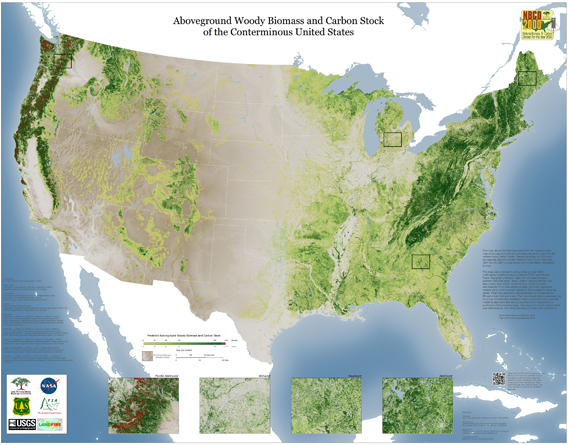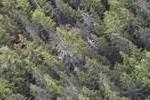
The National Biomass and Carbon Dataset (NBCD) map of the continental US courtesy of Woods Hole Research Center. Click to enlarge.
The Woods Hole Research Center (WHRC) has released the first hectare-scale map displaying aboveground woody biomass and forest carbon in US forests. The map, which also shows canopy heights, is known as the National Biomass and Carbon Dataset (NBCD).
“The dataset represents a comprehensive assessment of forest structure and carbon stock within the lower 48 States at the beginning of the third millennium, providing an important baseline with which to improve our understanding of the United States forest resources and its link to the terrestrial carbon flux in North America,” said Dr. Josef Kellndorfer, who led the project, adding that “this dataset will be useful to foresters, wildlife ecologists, resource managers, and scientists alike.”
The map shows forest conditions for the year 2000 and, as such, will provide a baseline for future changes to US forest cover.
“Naturally we are keen to produce the next generation data sets of this kind to assess in detail how carbon stock and forest structures are changing in this country, and internationally,” said Kellndorfer.
The map was funded under NASA’s Terrestrial Ecology Program with support from the Landscape Fire and Resource Management Planning Tools Project (LANDFIRE).
The map can be accessed at: Woods Hole Research Center’s National Biomass Carbon Dataset.
Related articles
Birnam Wood in the 21st Century: northern forest invading Arctic tundra as world warms

(03/07/2011) In Shakespeare’s play Macbeth the forest of Birnam Wood fulfills a seemingly impossible prophecy by moving to surround the murderous king (the marching trees are helped, of course, by an army of axe-wielding camouflaged Scots). The Arctic tundra may soon feel much like the doomed Macbeth with an army of trees (and invading species) closing in. In a recent study, researchers found that climate change is likely to push the northern forests of the boreal into the Arctic tundra—a trend that is already being confirmed in Alaska.
Forest carbon conservation project launched in Arkansas
(02/03/2011) The United States may not have capped its national greenhouse gas emissions, but the US state of California did cap its state emissions – and voters there seconded the state’s decision when they rejected Proposition 23, which would have all but killed cap-and-trade. The end of Prop 23 could mean the beginning of a great experiment to see if people in the United States can make money by doing good. This carbon fund is betting on a positive outcome.
Groups call on KFC to end greenwashing
(12/19/2010) A coalition of environmental groups is calling on Kentucky Fried Chicken to end its use of products carrying the Sustainable Forestry Initiative (SFI) certification label.